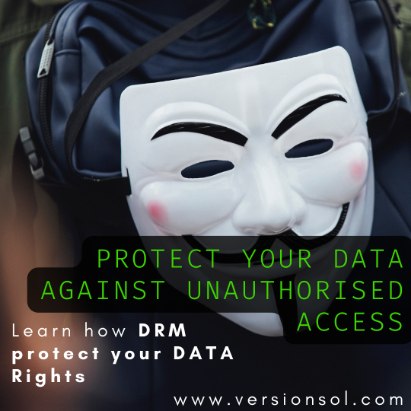Digital technologies and services use to implement limitations on the usage of digital content that has a license are known as Digital rights management or DRM.
Copyright laws for electronic content can be secured with the use of digital rights management. This strategy restricts the usage and duplication of electronic content. Companies or creators may restrict what people can do with certain material by using digital rights management. Businesses can prevent potential difficulties which arise from unlawful usage by employing digital rights control processes or solutions. It limits user access to use specific assets. DRM is now contributing more and more to secure data. DRM methods are not effective at catching cyber criminals.
Digital rights management examples
Content producers and copyright holders can prohibit individuals from altering their work or using it for undesired reasons by implementing DRM to secure digital content. DRM is employed across a broad spectrum of online content. From recreational items like publications, audio, and films to applications, software, and important corporate data.
Microsoft software: Before installing any downloadable Microsoft software, such as Windows or Office products, users must accept the terms of the firm’s user agreement and provide a security code. Play Ready is a good example that uses a DRM system to limit or secure digital content over the internet as well as prohibits unlawful use of its services.
Important records: To protect company records or confidential material, such as private employee details, business strategies, and agreements, several organizations use DRM technologies.
Regulatory adherence: DRM is essential for assisting firms in observing data protection laws.
Related: Why IT companies need technology liability insurance
The importance of digital rights management
As digital content grows via community file transfers, just like torrent websites, and online piracy, DRM is becoming more and more crucial. It assists entertainment and media enterprises in defending themselves against the cyber threats that all businesses may deal with, including safeguarding client data, securing and proving conformity, improving operational effectiveness, and avoiding downtime.
Authors, singers, filmmakers, and other content producers can use DRM to specify and restrict how users are interacting and using the product/services. Additionally, it enables users to safeguard the time and money they invested in creating the production, secure the copyrighted material, and block malicious sharing or theft of the assets. For instance, they can restrict access to certain assets to help them avoid any potential legal ramifications from unauthorized use. This is essential for preserving intellectual property rights and copyrights.
How do turn on digital rights management?
Anyone can use DRM technology via software programs and hardware solutions. Both strategies give content producers the ability to stop intentional piracy and unintentional illegal use. With the help of DRM, Businesses can manage the users who have access to copyrighted content. Big companies and or individual creators can accomplish this in many ways, such as:
Watermarks
Content can have watermarks tagged on the products or files so that the owners of the copyrights or the authors can monitor any illegal use.
Digital assets have metadata
Digital assets have metadata, which makes it possible to record and keep track of the ownership and registration information. To track licensing information for stock music, images, and video content and prevent unlawful use, is crucial.
With embedded tags, copyright holders can manage how and where the content is available online. This is helpful if the license for electronic media changes or runs out because DRM makes it possible to renew the licenses everywhere the associated embed code has been published online.
Related: Top 10 disruptive technologies
License agreements: Businesses can safeguard the technology and data by mandating that users understand and agree to their end-user license agreements. The first time a user enters a website, exchanges data, or saves stuff, they agree to an Agreement, which aids businesses in preventing unlawful use of company products.
ADVANTAGES OF DRM
Solutions for digital rights management enable sharing of data/files while maintaining control over how to use data. Some other key benefits of DRM include:
- Data protection management informs users regarding copyrighted material and licensing agreements.
- DRM makes room for improved license agreements and technological advancements
- Digital rights management assists writers in maintaining custody of the creations.
- Preserving income
- By using DRM, content producers may guarantee that only paying customers can enjoy the media.
- DRM safeguards revenue sources
- Digital rights management can help protect files and maintain their confidentiality
Related: What is Digital twin technology?
